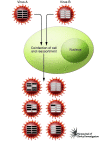RNA virus genomics: a world of possibilities
- PMID: 19729846
- PMCID: PMC2735898
- DOI: 10.1172/JCI38050
RNA virus genomics: a world of possibilities
Abstract
The increasing availability of complete genome sequences of RNA viruses has the potential to shed new light on fundamental aspects of their biology. Here, I use case studies of 3 RNA viruses to explore the impact of genomic sequence data, with particular emphasis on influenza A virus. Notably, the studies of RNA virus genomics undertaken to date largely focused on issues of evolution and epidemiology, and they have given these disciplines new impetus. However, genomic data have so far made fewer inroads into areas of more direct importance for disease, prevention, and control; thus, harnessing their full potential remains an important goal.
Figures




References
-
- WHO. 2003. Fact sheet N°211. Influenza. http://www.who.int/mediacentre/factsheets/fs211/.

